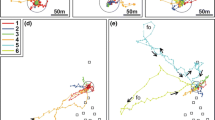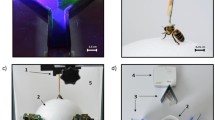Abstract
To investigate the priming of memories by contextual cues, bees were trained to negotiate two mazes in different places 25 m apart. In the first maze, bees flew leftwards when the inner wall of the maze was covered with 45° stripes or rightwards when the inner wall was coloured yellow. In the second maze, bees flew rightwards on viewing 135° diagonal stripes or leftwards on viewing blue. The trajectories evoked by 45° or 135° stripes were similar in both mazes. However, vertical stripes were treated like 45° stripes in maze 1 and like 135° stripes in maze 2. Contextual cues prime the response to stripes that are oriented in the training condition for that site so influencing responses to stripes in closely neighbouring orientations. What objects in a bee's surroundings determine its sense of place? Bees were trained to different visual patterns at two sites 40 m apart (A+ versus A– at site A, and E+ versus E– at site E). A+ was preferred over A– and E+ was preferred over E– at both training sites. A preference for A+ over E+ exhibited at site A dropped gradually with distance to suggest that spatial context includes both close and distant objects.
Similar content being viewed by others
Author information
Authors and Affiliations
Additional information
Accepted: 15 May 1997
Rights and permissions
About this article
Cite this article
Collett, T., Fauria, K., Dale, K. et al. Places and patterns — a study of context learning in honeybees. J Comp Physiol A 181, 343–353 (1997). https://doi.org/10.1007/s003590050120
Issue Date:
DOI: https://doi.org/10.1007/s003590050120




